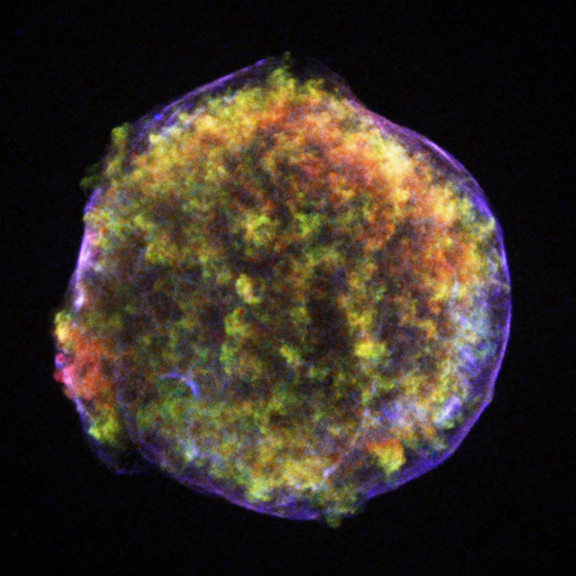Here’s your image for this week’s “Where In The Universe” challenge. Take a look and see if you can name where in the Universe this image is from. Give yourself extra points if you can name the spacecraft responsible for the image. The new way we’re doing this challenge is that we’ll provide the image today, but won’t reveal the answer until tomorrow. This gives you a chance to mull over the image and provide your answer/guess in the comment section — if you dare. Check back tomorrow on this same post (reminder: no new post tomorrow — come back to this one) to see how you did!
UPDATE (11/6): The answer has now been posted below. If you haven’t made your guess yet, no peeking before you do!!
I have to say, I am impressed with the knowledge of you UT readers! Great job! Yes, it is Tycho’s Supernova Remnant, taken by the Chandra spacecraft. This is a bubble of hot gaseous supernova debris (green and red) inside a more rapidly moving shell of extremely high-energy electrons (blue). These features were created as the supersonic expansion of the debris into interstellar gas produced two shock waves – one that moves outward and accelerates particles to high energies, and another that moves backward and heats the stellar debris. The Chandra X-ray Observatory, which was launched and deployed by Space Shuttle Columbia on July 23, 1999, took this image in 2005.
Learn more about the image here.
And I’m sorry about the delay in posting the answer.


I think it’s a supernova remnant, because of the shock front. One of the space telescopes; I’ll bet on Spitzer, but may as well be Hubble
Supernova remnant. Type Ia. It’s either Tycho or Kepler — I always mix those two up.
tychos supernova
Another tough one…
This is a supernova remnant, but don’t ask me to actually name it. They all look more or less alike to me.
As for the spacecraft… hm… Chandra?
Tychos supernova, exploded on 11 November 1572.
Now, 20 ly across, the debris cloud is still expanding…
Tycho’s supernova remnant indeed.
Yep – Tycho’s SNR in X-rays with Chandra.
Not sure which supernova, spitzer.
Tycho’s Supernova remnant in xrays, not sure on the spacecraft, i guess Chandra?
Definitely a Chandra image of a Galactic SNR, though I am not sure if it’s Tycho’s SNR or Cassiopeia A. The consensus here seems Tycho’s. Pretty clearly a Type Ia explaosion, there’s no central remnant.
The red-green roiling stuff is probably multi-megaK gas, while the blue ring is the outer shock front, where electrons are accelerated over the shock boundaries and emit synchrotron radiation by spiralling in magnetic fields. This radiation is harder than the thermal radiation, which is why it is seen mostly in the hardest energy channel which is coded blue.
My guess was the sun and SOHO. Second straight week, but I’m sticking to my answer.
I’m a big fat cheat! I had a peak at chandra.harvard.edu and yeah it’s what’s left of Tycho’s nose…
That’s Tycho’s remnant taken by Chandra.
i think the photo is showing an end of a galaxy or a star
A late entry.
It certainly looks like a supernova remnant but there again I once produced a petri dish growth that looked remarkably similar!
It is a supernova remenant for sure, probably taken by Chandra…Not sure which one though…
ok i had a peek at the comments…so guess i am partially correct!! …
SN1572, known as Tycho’s supernova, as seen by Chandra (ie in X-ray) on 29:th of April 2003. For once I actually new right away what I was looking at. Yes! I admit, though, I had too look up some details on the net to be sure.
/Adam
well certainely this is tycho’s supernova .it is also known as sn1572 and it was seen by chandra on december 2003 .maybe the energy produced by that supernova is still expanding.
Island volcano eruption on earth photographed from above, in ultraviolet or such…
*Hehe* The name the popped into my mind was Kepler’s Supernova. Of course, I know it’s a remnant. 🙂
The colouring and generally the gas surrounding it told me that t an X-ray telescope was involved. My guess, Chandra.
SN1006 (in Lupus)
Tycho’s supernova in X-Ray light taken by Chandra. This was an APOD many years ago. I guess the “where” is Cassiopeia.
What’s the difference between a supernova reminant and a planetary nebula?
I”m going to say it’s a planetary nebulae. And the other guess is that it’s a “triple telescope” image taken from Hubble, Chandra and Spitzer that’s been combined.
@Duvvy
A supernova remnant is what’s left after a supernova goes off. Since the explosion shoots energy (and matter) in all directions, it’s usually relatively spherical with a bowshock and plenty of stuff in the middle, and shines brightly in X-rays.
A planetary nebula is the result of a less massive star shedding its outer layers as it contracts from the red giant phase to the white dwarf phase. Its structure is usually not spherical and bipolar, for reasons I’ll let others try to explain, ’cause that’s over my head (or you can try to find out yourself). it shines in the visible and ultraviolet.
In a nutshell.
I wrote: “Its structure is usually not spherical and bipolar”, and after posting I realized this is a confusing sentence. What I meant is that the structure is usually bipolar instead of spherical, although there can also be found spherical planetary nebulae.
So, here it is 7:15 PM EST on the “next day”, So, when do you actually publish the soution??
Great picture. Naturally, after posting my answer I googled the answers everyone else gave and saw that they were right…again. Oh well. Maybe next time!
Don’t know where it’s at…but where ever it is, it looks awesome…